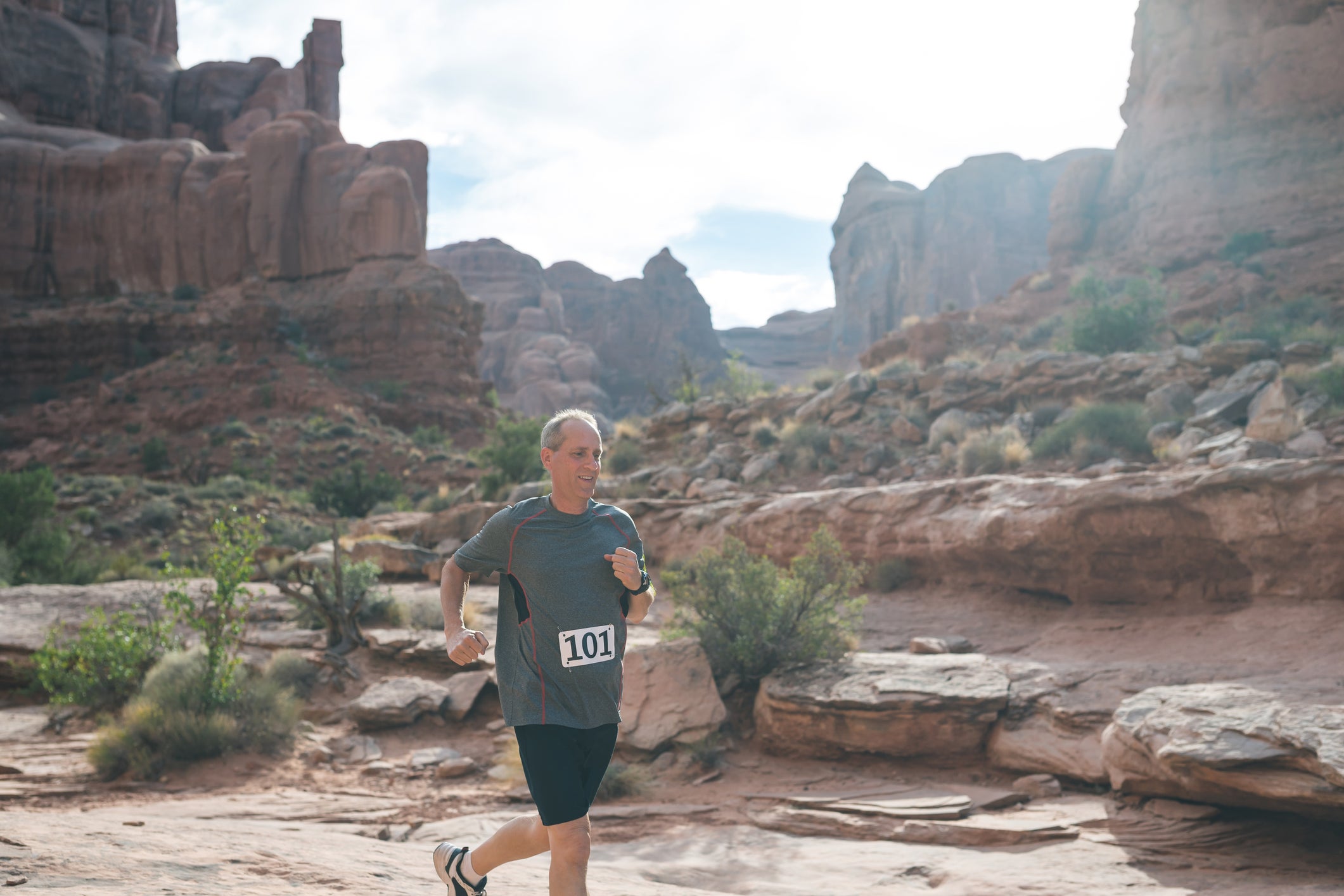What Heat Acclimation Looks Like for Masters Runners

A senior male wearing a race number jogs through the desert as part of a charity run he's participating in. Giant rock monoliths and formations are rising up in the background.
Summer running can be a sufferfest. Relentless heat and oppressive humidity have us squeezing in runs at the crack of dawn or after sunset. For most runners, these efforts to stay cool are all in the name of comfort. For masters runners, they’re a matter of health. Here’s how masters runners can beat the heat.
RELATED: Here’s How To Make The Most Of Heat Training
A Slower Response to Heat
As we age, every system in our body slows down—including our nervous system. This system not only tells our muscles to fire, but also alerts us when we’re getting hot, telling our body to cool down.
“When we heat up, we have neural signals that are sent to cutaneous vasculature, or blood vessels in the skin, as well as to sweat glands,” says S. Tony Wolf, a postdoctoral fellow in the department of kinesiology at Penn State University. In response to these signals, the blood vessels in our skin dilate, or widen, so our blood can get closer to the surface of the skin and release more heat into the air. Meanwhile, our sweat glands release water onto the surface of our skin, which cools us through evaporative heat loss.
Over time, this whole system becomes less responsive: It’s slower to register that we’re hot and send out cooling signals; blood vessels and sweat glands are slower to react. Add a decreased thirst response (another system slowdown) and you wind up with a body prone to overheating and dehydrating more quickly and severely.
RELATED: The Basics of Heat Training for Running
Big Races, Big Risks
Magdalena Boulet, a 2008 Olympic marathoner and 47-year-old professional ultrarunner, knew that heat regulation would be key when she signed up for the 2018 Marathon des Sables—a six-day, 156-mile ultramarathon across the Sahara Desert. Similarly, Lyndsay Tessier, a 43-year-old elite Canadian masters runner, was aware of the risks she would face at the 2019 world marathon championships. The race took place in Doha, Qatar, where the daily high averages more than 100 degrees Fahrenheit with a low in the mid-80s.
“I was decidedly older than everyone else [on the Canadian team],” she says. “And you can’t outrun the heat. But what you can do is respect and prepare for it.”
RELATED: Heat Acclimation for Athletes Who Hate the Heat
Preparation Means Acclimation
Whether you’re training for a hot race or approaching intense summer months, the first thing to do is to acclimate. The goal: Help your body make the adaptations it needs to handle heat, including increased sweat rate, reduced resting core temperature, and expanded plasma volume.
According to research, most heat acclimation adaptations are complete after 10 continuous days of heat exposure. But not all of us have access to the same resources as a researcher, so our acclimation may take longer.
Boulet, for example, uses the last four weeks before a hot race to acclimate. “You have to be very thoughtful that you don’t incorporate this extra stress from heat acclimation during intense phases of your training,” she says. She starts with passive exposure, like sitting in a hot tub, and increases the intensity from there.
An even easier technique: Wear extra clothes during indoor and outdoor runs. Begin in whichever setting is colder, working up to multiple layers in the hotter setting.
RELATED: The Science And History Of Heat Training
When It’s Hot, Keep Your Cool
When it’s time to push yourself in the heat, the approach flips. Now you want to stay as cool as possible for as long as possible.
In Doha, Tessier was advised to stay out of the heat as much as she could before the race. She was also given cooling vests to wear before she started, which you can DIY: Wet a few hand towels, freeze them overnight, and drape them over your head and neck for 10 minutes before a hot run.
Or try cooling down from the inside. Boulet freezes her water bottles and gels so everything she’s ingesting helps to cool her down. And make sure to drink enough fluid. Because once you’re dehydrated, it’s easier to overheat more quickly.
Finally, back off when needed. Tessier credits her top-10 finish with hitting a pace 15–20 seconds slower than what she’d trained for. “That’s where being a master comes in. There’s a maturity where I’m able to calm my ego. I told myself, ‘You’re just going to race the conditions. You won’t race your fitness, per se.’ Respect the heat. Don’t fear it, but respect it.”